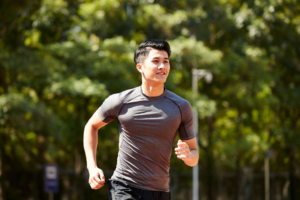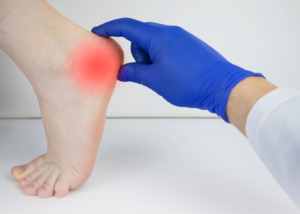You’ve been refraining from playing your favourite sports. You’ve turned your friends down for long walks, instead resting and mentally willing your achilles tendon to get better. You’ve spent months making changes to your daily life to spend less time on your feet, and yet when you think it might be time to test the waters and go for a jog, the pain is still there – or it’s back – and you’re left feeling frustrated with the lack of progress. Enough is enough – here’s what you should know about achilles tendinopathy and how to finally beat it.
What is Achilles Tendinopathy?
Achilles tendinopathy describes damage to your achilles tendon – the tendon that joins your calf muscles to your heel. If you feel the cord-like structure up the back of your heel – that’s the one! Because this tendon has to tolerate and support incredibly high forces as you move – particularly in running and jumping activities where it may be up to twelve times your body weight – it can become injured, torn or even ruptured.
Interestingly, unlike most tendonitis’ that involve inflammation of the affected tendon, damage to the achilles tendon follows a slightly different pathway where the focus isn’t on the inflammation (tendonitis) but on the damage to and degeneration of the tendon fibres (tendinopathy). This means that recovery needs to be less focused on rest and ice and more focused on strengthening the tendon back to its normal function.
Because the achilles tendon can be damaged in multiple ways that may or may not involve surrounding structures, or may only involve surrounding structures, if your achilles pain has not settled after a few days then you need to see your Podiatrist or you may end up treating the wrong cause for months on end.
What are the symptoms?
Generally, symptoms involve pain and discomfort through the achilles tendon, whether it be at the insertion at the heel or further up the tendon. Additionally:
- Pain that is exacerbated by running, especially uphill
- Pain on pinching the achilles tendon
- Stiffness through the back of the heel and up the leg
- Inflammation of tissues surrounding the achilles tendon
What causes achilles tendinopathy?
One of the greatest causes of developing this tendinopathy is ignoring early achilles pain and continuing to exercise while thinking it’ll just go away and resolve. You don’t get achilles pain for no reason – you get it because the tendon is being overloaded and it wants you to stop.
Other causes include any activity that puts excess tension or your achilles tendon, such as:
- Increasing training intensity
- Increasing hill running duration
- Unsupportive footwear with low set heels
- Tight calf muscles
- Abnormal foot biomechanics that exacerbate the pull on the calves and achilles
- Running/jumping sports such as basketball
How should I treat it?
The first thing you should do if you’re getting pain in your achilles is to stop the activity that’s triggering it. Don’t worry, you’ll be able to get back to that activity in due time! Next, you need to have the extent of the damaged assessed. You may have incurred a small amount of damage, or the tendon may have a tear or even have ruptured. There is always the risk of the damage progressing if it’s not managed effectively and you may develop chronic, ongoing pain.
At Sole Motion Podiatry we begin with a thorough biomechanical assessment of your feet and legs to not only assess the extent of the damage but to find out the cause of the damage – because there’s little point in perfectly treating your achilles if your foot posture means the pain is just going to come back in a month. We test everything from the range of motion available through your joints, to your muscle strength, to how your feet and legs move through gait and more. From here we’ll let you know how to get better as fast as possible – and stay better. Better yet, we work with you and your life so you can keep doing the things you love throughout your recovery, though there may be some temporary activity modification.
The Sole Motion difference
A big point of difference between our approach and others is our key focus on intrinsic strength to not only get you better faster but to keep you strong, healthy, and smashing all your goals. We’re committed to you and to clinical excellence in podiatric sports medicine – one of our specialities – because we love seeing our patients get back to doing the things they love and feeling great.
We feel privileged to get to help so many people in Melbourne each day and would love to help you too – we’re on your team! Give us a call on 1300-FX-FEET today.





